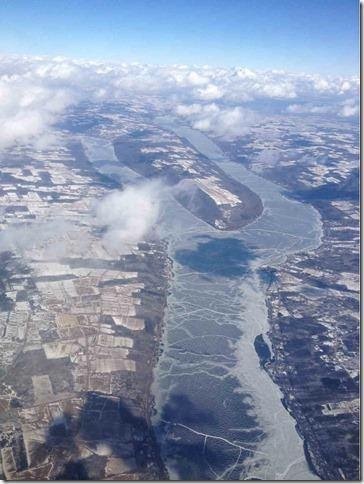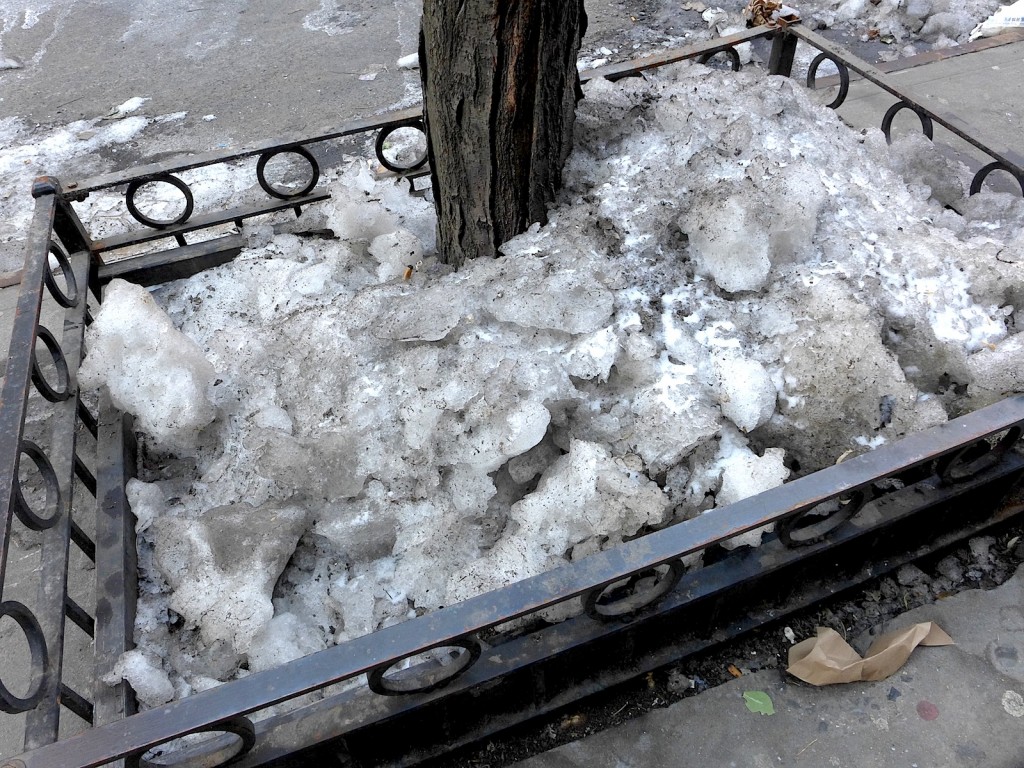Yes, today maybe the last day of winter in New York Wine City (NYWC) and things like this which sat in front of the door to tha apartment building on West 16th Street that I live in when I’m in NYWC for what seemed like an eternity may soon be just memories. The last time there was a winter like this in my other home city, Berlin, some people started doubting there was such a thing as climate change, and I hope nobody here makes that mistake. Perhaps all the terrible storms of the last months will make it clear to them that it was just a particularly cold winter. There is certainly a fundamental difference between weather (short term phenomena) and climate (long-term patterns). However, that is small cheer to those winegrowers who’s vineyards have suffered frost damage this winter. That could seriously reduce the size of the 2014 crop and we are also talking Riesling east of the Mississippi.
 This dramatic picture of Keuka Lake in the Finger Lakes (FLX) from the air recently was supplied to me by Jim Trezise of the New York Wine & Grape Foundation. It shows that the lake was almost completely frozen, which means that for a while it ceased to function as a natural frost amelioration system. Bob Madill, one of the founders of Sheldrake Point winery on Cayuga Lake (the northern part of which also froze over) in the FLX reported that about 18% of the vines’ buds had been killed this winter, which is rather less than I’d feared. The Riesling vines will probably compensate for most of that loss. I haven’t heard yet what the figure on the Old Mission and Leelanau Peninsulas in Northern Michigan where most of the lake appears to have frozen over this winter. Of course, this is all science fiction and finding out how the 2013 vintage wines taste in the two major Riesling producing regions on the eastern side of the US, plus the Niagara Peninsula in Ontario/Canada, comes first for me.
This dramatic picture of Keuka Lake in the Finger Lakes (FLX) from the air recently was supplied to me by Jim Trezise of the New York Wine & Grape Foundation. It shows that the lake was almost completely frozen, which means that for a while it ceased to function as a natural frost amelioration system. Bob Madill, one of the founders of Sheldrake Point winery on Cayuga Lake (the northern part of which also froze over) in the FLX reported that about 18% of the vines’ buds had been killed this winter, which is rather less than I’d feared. The Riesling vines will probably compensate for most of that loss. I haven’t heard yet what the figure on the Old Mission and Leelanau Peninsulas in Northern Michigan where most of the lake appears to have frozen over this winter. Of course, this is all science fiction and finding out how the 2013 vintage wines taste in the two major Riesling producing regions on the eastern side of the US, plus the Niagara Peninsula in Ontario/Canada, comes first for me.
In California a paradoxical, if not bizarre, situation has developed. The state is suffering what is probably its worst drought since the white man first set eyes on the West Coast of North America and this is seriously impacting agriculture in the state. That’s important because, for example, the state grows virtually the almonds, pistachios and walnuts in North America. In fact, it grows most of the world’s almonds and prices for them are already rising. However, the state’s wine industry had two big crops in 2013 (4.23 million tons) and 2012 (4.02 million tons). In contrast, the 2011 and 2010 wine harvests were both short. Excepting a few politicians, California seems to have a healthy grip on the reality of the drought though, perhaps because this is far from being the first drought the state has suffered in living memory. The first 2013s I’ve tasted from California (see the posting below for one example) were impressive and across the board the 2012s shine as long as they weren’t over-oaked and other winemaking stupidities were avoided.
In Western Europe there was hardly any winter at all and recent days have seen warm spring weather that make an early bud-break of the vines inevitable opening up the very real danger of spring frost damage to the delicate young shoots. Now that would lead to enormous crop losses, because the vines cannot compensate for that. Of course, what kind of growing season the wine regions will get in 2014 and what kind of summer we’ll get this year in NYWC is anybody’s guess.


![120114_riesling_global_RZ [1600x1200]](http://www.stuartpigott.de/wp-content/uploads/2014/03/120114_riesling_global_RZ-1600x12006.jpg)
I don’t even know how I ended up here, but I thought
this post was good. I do not know who you are but definitely you’re going to a famous blogger if you aren’t already 😉 Cheers!
I’m really impressed along with your writing abilities and also with the structure in your weblog.
Is this a paid subject matter or did you
modify it your self? Either way stay up the excellent high
quality writing, it’s uncommon to see a nice blog like this one nowadays..